Analysis of Training and Development Management in Organizations
VerifiedAdded on 2020/06/06
|17
|5090
|53
Report
AI Summary
This report provides a comprehensive analysis of training and development management, exploring various leadership styles such as autocratic, affiliative, coaching, democratic, pace setting, and visionary approaches. It examines the characteristics of effective leadership, including empathy, consistency, honesty, and communication. The report delves into different communication processes, highlighting the importance of two-way communication in organizations like Hilton Hotel. Furthermore, it analyzes the impact of organizational culture on employee performance and satisfaction. The report also outlines essential management skills, such as planning, coordinating, directing, and problem-solving, and their influence on employee performance. Additionally, it covers employee motivation strategies, managerial decision-making, and the development of career development plans, offering insights into how managerial and personal skills contribute to career advancement. The report is a student submission available on Desklib, a platform for AI-powered study tools.
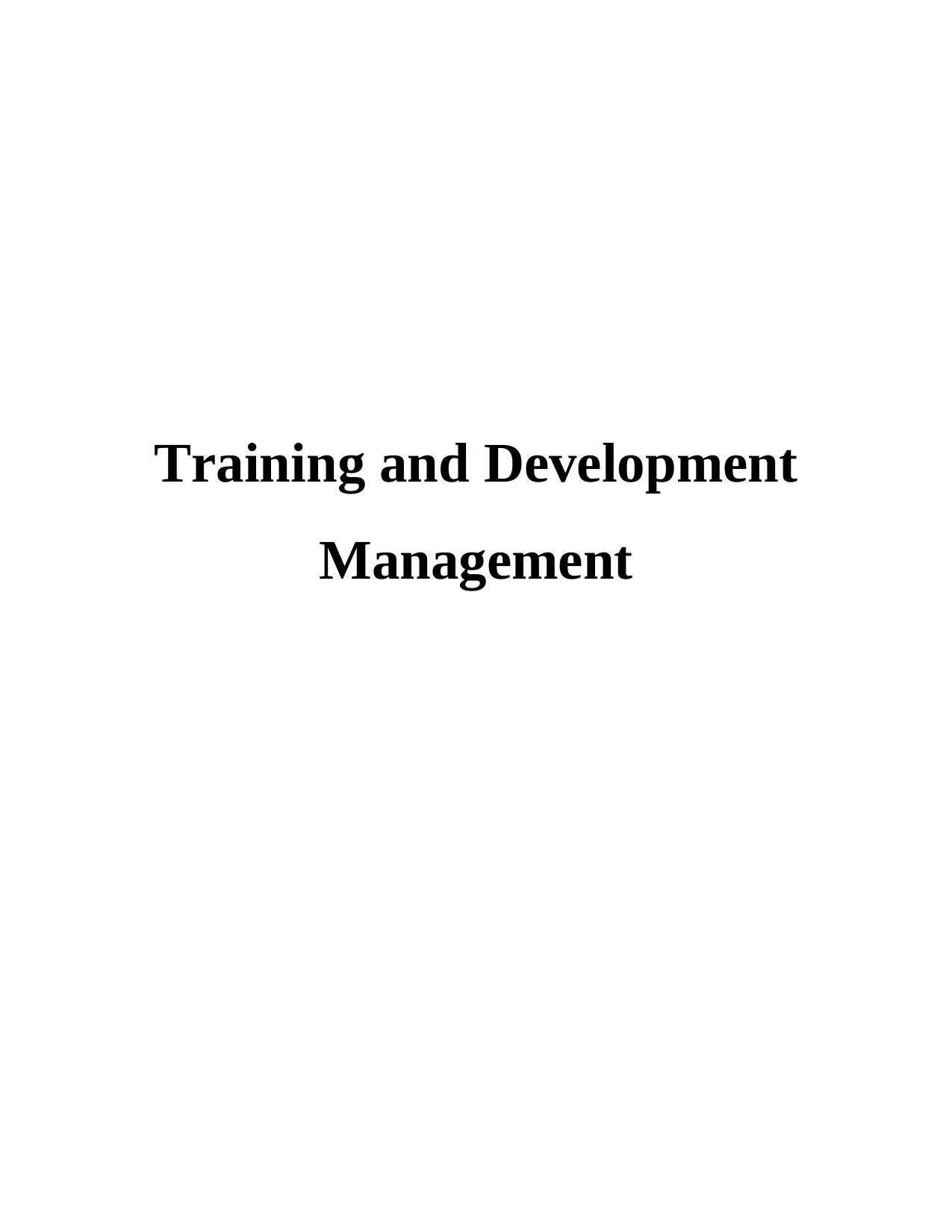
Training and Development
Management
Management
Paraphrase This Document
Need a fresh take? Get an instant paraphrase of this document with our AI Paraphraser
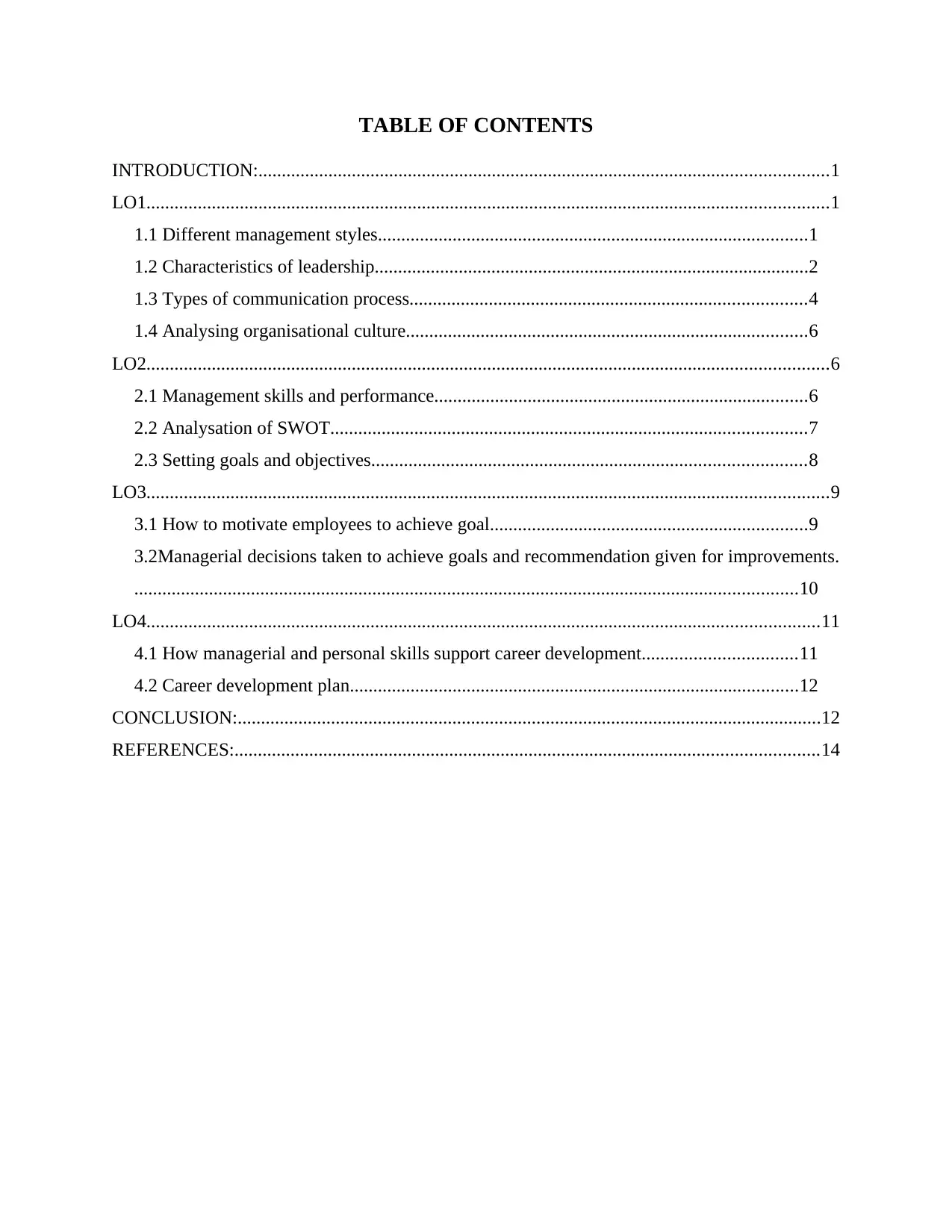
TABLE OF CONTENTS
INTRODUCTION:..........................................................................................................................1
LO1..................................................................................................................................................1
1.1 Different management styles............................................................................................1
1.2 Characteristics of leadership.............................................................................................2
1.3 Types of communication process.....................................................................................4
1.4 Analysing organisational culture......................................................................................6
LO2..................................................................................................................................................6
2.1 Management skills and performance................................................................................6
2.2 Analysation of SWOT......................................................................................................7
2.3 Setting goals and objectives.............................................................................................8
LO3..................................................................................................................................................9
3.1 How to motivate employees to achieve goal....................................................................9
3.2Managerial decisions taken to achieve goals and recommendation given for improvements.
..............................................................................................................................................10
LO4................................................................................................................................................11
4.1 How managerial and personal skills support career development.................................11
4.2 Career development plan................................................................................................12
CONCLUSION:.............................................................................................................................12
REFERENCES:.............................................................................................................................14
INTRODUCTION:..........................................................................................................................1
LO1..................................................................................................................................................1
1.1 Different management styles............................................................................................1
1.2 Characteristics of leadership.............................................................................................2
1.3 Types of communication process.....................................................................................4
1.4 Analysing organisational culture......................................................................................6
LO2..................................................................................................................................................6
2.1 Management skills and performance................................................................................6
2.2 Analysation of SWOT......................................................................................................7
2.3 Setting goals and objectives.............................................................................................8
LO3..................................................................................................................................................9
3.1 How to motivate employees to achieve goal....................................................................9
3.2Managerial decisions taken to achieve goals and recommendation given for improvements.
..............................................................................................................................................10
LO4................................................................................................................................................11
4.1 How managerial and personal skills support career development.................................11
4.2 Career development plan................................................................................................12
CONCLUSION:.............................................................................................................................12
REFERENCES:.............................................................................................................................14
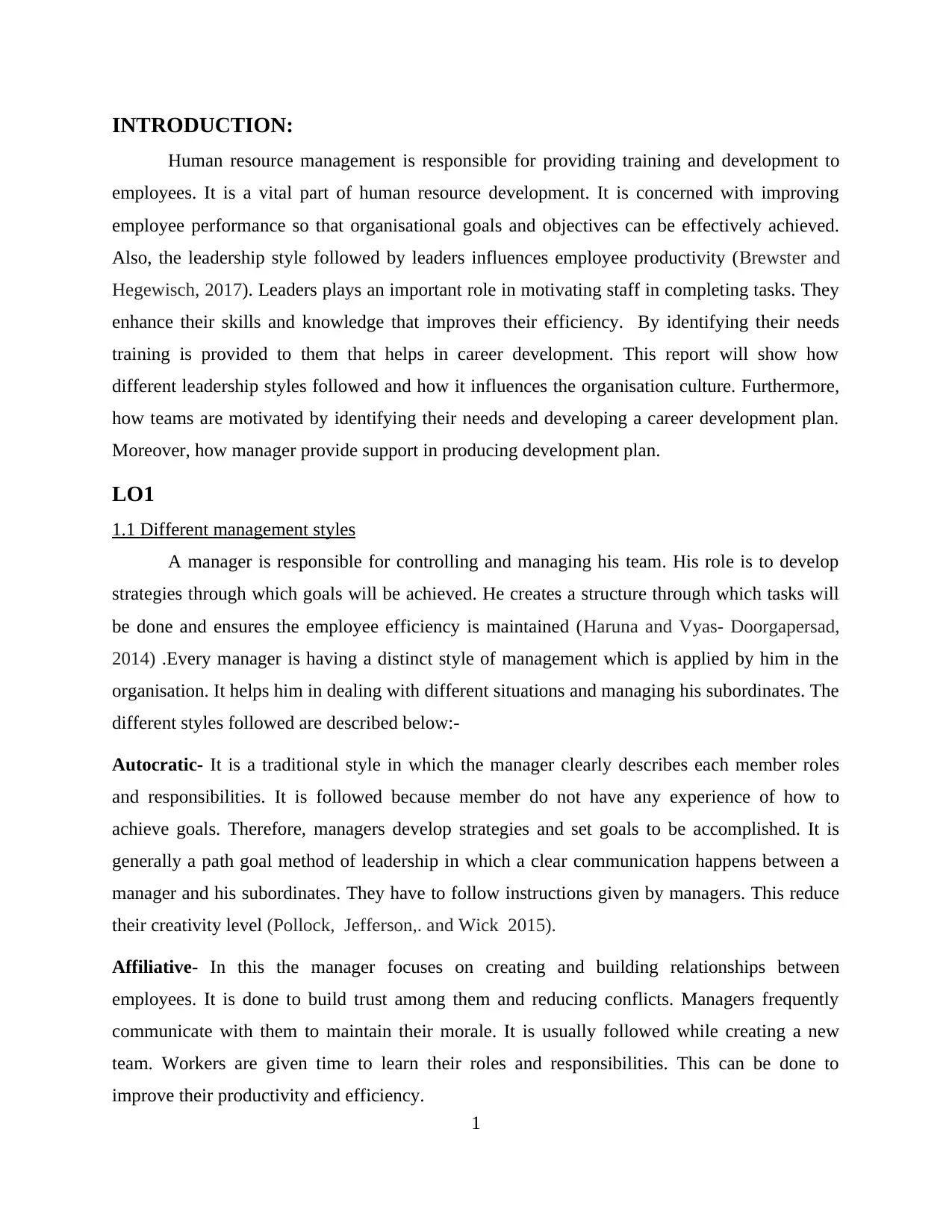
INTRODUCTION:
Human resource management is responsible for providing training and development to
employees. It is a vital part of human resource development. It is concerned with improving
employee performance so that organisational goals and objectives can be effectively achieved.
Also, the leadership style followed by leaders influences employee productivity (Brewster and
Hegewisch, 2017). Leaders plays an important role in motivating staff in completing tasks. They
enhance their skills and knowledge that improves their efficiency. By identifying their needs
training is provided to them that helps in career development. This report will show how
different leadership styles followed and how it influences the organisation culture. Furthermore,
how teams are motivated by identifying their needs and developing a career development plan.
Moreover, how manager provide support in producing development plan.
LO1
1.1 Different management styles
A manager is responsible for controlling and managing his team. His role is to develop
strategies through which goals will be achieved. He creates a structure through which tasks will
be done and ensures the employee efficiency is maintained (Haruna and Vyas- Doorgapersad,
2014) .Every manager is having a distinct style of management which is applied by him in the
organisation. It helps him in dealing with different situations and managing his subordinates. The
different styles followed are described below:-
Autocratic- It is a traditional style in which the manager clearly describes each member roles
and responsibilities. It is followed because member do not have any experience of how to
achieve goals. Therefore, managers develop strategies and set goals to be accomplished. It is
generally a path goal method of leadership in which a clear communication happens between a
manager and his subordinates. They have to follow instructions given by managers. This reduce
their creativity level (Pollock, Jefferson,. and Wick 2015).
Affiliative- In this the manager focuses on creating and building relationships between
employees. It is done to build trust among them and reducing conflicts. Managers frequently
communicate with them to maintain their morale. It is usually followed while creating a new
team. Workers are given time to learn their roles and responsibilities. This can be done to
improve their productivity and efficiency.
1
Human resource management is responsible for providing training and development to
employees. It is a vital part of human resource development. It is concerned with improving
employee performance so that organisational goals and objectives can be effectively achieved.
Also, the leadership style followed by leaders influences employee productivity (Brewster and
Hegewisch, 2017). Leaders plays an important role in motivating staff in completing tasks. They
enhance their skills and knowledge that improves their efficiency. By identifying their needs
training is provided to them that helps in career development. This report will show how
different leadership styles followed and how it influences the organisation culture. Furthermore,
how teams are motivated by identifying their needs and developing a career development plan.
Moreover, how manager provide support in producing development plan.
LO1
1.1 Different management styles
A manager is responsible for controlling and managing his team. His role is to develop
strategies through which goals will be achieved. He creates a structure through which tasks will
be done and ensures the employee efficiency is maintained (Haruna and Vyas- Doorgapersad,
2014) .Every manager is having a distinct style of management which is applied by him in the
organisation. It helps him in dealing with different situations and managing his subordinates. The
different styles followed are described below:-
Autocratic- It is a traditional style in which the manager clearly describes each member roles
and responsibilities. It is followed because member do not have any experience of how to
achieve goals. Therefore, managers develop strategies and set goals to be accomplished. It is
generally a path goal method of leadership in which a clear communication happens between a
manager and his subordinates. They have to follow instructions given by managers. This reduce
their creativity level (Pollock, Jefferson,. and Wick 2015).
Affiliative- In this the manager focuses on creating and building relationships between
employees. It is done to build trust among them and reducing conflicts. Managers frequently
communicate with them to maintain their morale. It is usually followed while creating a new
team. Workers are given time to learn their roles and responsibilities. This can be done to
improve their productivity and efficiency.
1
⊘ This is a preview!⊘
Do you want full access?
Subscribe today to unlock all pages.

Trusted by 1+ million students worldwide
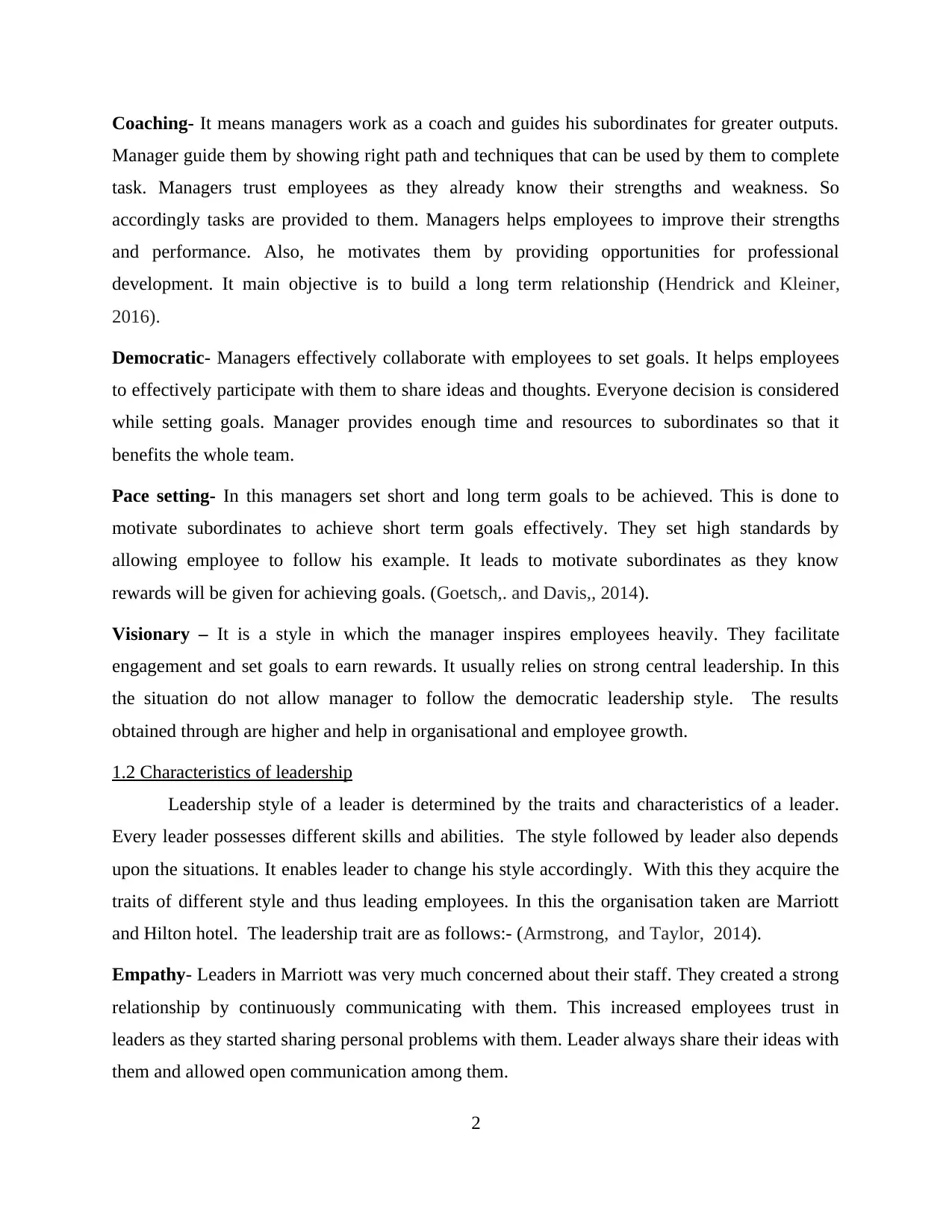
Coaching- It means managers work as a coach and guides his subordinates for greater outputs.
Manager guide them by showing right path and techniques that can be used by them to complete
task. Managers trust employees as they already know their strengths and weakness. So
accordingly tasks are provided to them. Managers helps employees to improve their strengths
and performance. Also, he motivates them by providing opportunities for professional
development. It main objective is to build a long term relationship (Hendrick and Kleiner,
2016).
Democratic- Managers effectively collaborate with employees to set goals. It helps employees
to effectively participate with them to share ideas and thoughts. Everyone decision is considered
while setting goals. Manager provides enough time and resources to subordinates so that it
benefits the whole team.
Pace setting- In this managers set short and long term goals to be achieved. This is done to
motivate subordinates to achieve short term goals effectively. They set high standards by
allowing employee to follow his example. It leads to motivate subordinates as they know
rewards will be given for achieving goals. (Goetsch,. and Davis,, 2014).
Visionary – It is a style in which the manager inspires employees heavily. They facilitate
engagement and set goals to earn rewards. It usually relies on strong central leadership. In this
the situation do not allow manager to follow the democratic leadership style. The results
obtained through are higher and help in organisational and employee growth.
1.2 Characteristics of leadership
Leadership style of a leader is determined by the traits and characteristics of a leader.
Every leader possesses different skills and abilities. The style followed by leader also depends
upon the situations. It enables leader to change his style accordingly. With this they acquire the
traits of different style and thus leading employees. In this the organisation taken are Marriott
and Hilton hotel. The leadership trait are as follows:- (Armstrong, and Taylor, 2014).
Empathy- Leaders in Marriott was very much concerned about their staff. They created a strong
relationship by continuously communicating with them. This increased employees trust in
leaders as they started sharing personal problems with them. Leader always share their ideas with
them and allowed open communication among them.
2
Manager guide them by showing right path and techniques that can be used by them to complete
task. Managers trust employees as they already know their strengths and weakness. So
accordingly tasks are provided to them. Managers helps employees to improve their strengths
and performance. Also, he motivates them by providing opportunities for professional
development. It main objective is to build a long term relationship (Hendrick and Kleiner,
2016).
Democratic- Managers effectively collaborate with employees to set goals. It helps employees
to effectively participate with them to share ideas and thoughts. Everyone decision is considered
while setting goals. Manager provides enough time and resources to subordinates so that it
benefits the whole team.
Pace setting- In this managers set short and long term goals to be achieved. This is done to
motivate subordinates to achieve short term goals effectively. They set high standards by
allowing employee to follow his example. It leads to motivate subordinates as they know
rewards will be given for achieving goals. (Goetsch,. and Davis,, 2014).
Visionary – It is a style in which the manager inspires employees heavily. They facilitate
engagement and set goals to earn rewards. It usually relies on strong central leadership. In this
the situation do not allow manager to follow the democratic leadership style. The results
obtained through are higher and help in organisational and employee growth.
1.2 Characteristics of leadership
Leadership style of a leader is determined by the traits and characteristics of a leader.
Every leader possesses different skills and abilities. The style followed by leader also depends
upon the situations. It enables leader to change his style accordingly. With this they acquire the
traits of different style and thus leading employees. In this the organisation taken are Marriott
and Hilton hotel. The leadership trait are as follows:- (Armstrong, and Taylor, 2014).
Empathy- Leaders in Marriott was very much concerned about their staff. They created a strong
relationship by continuously communicating with them. This increased employees trust in
leaders as they started sharing personal problems with them. Leader always share their ideas with
them and allowed open communication among them.
2
Paraphrase This Document
Need a fresh take? Get an instant paraphrase of this document with our AI Paraphraser
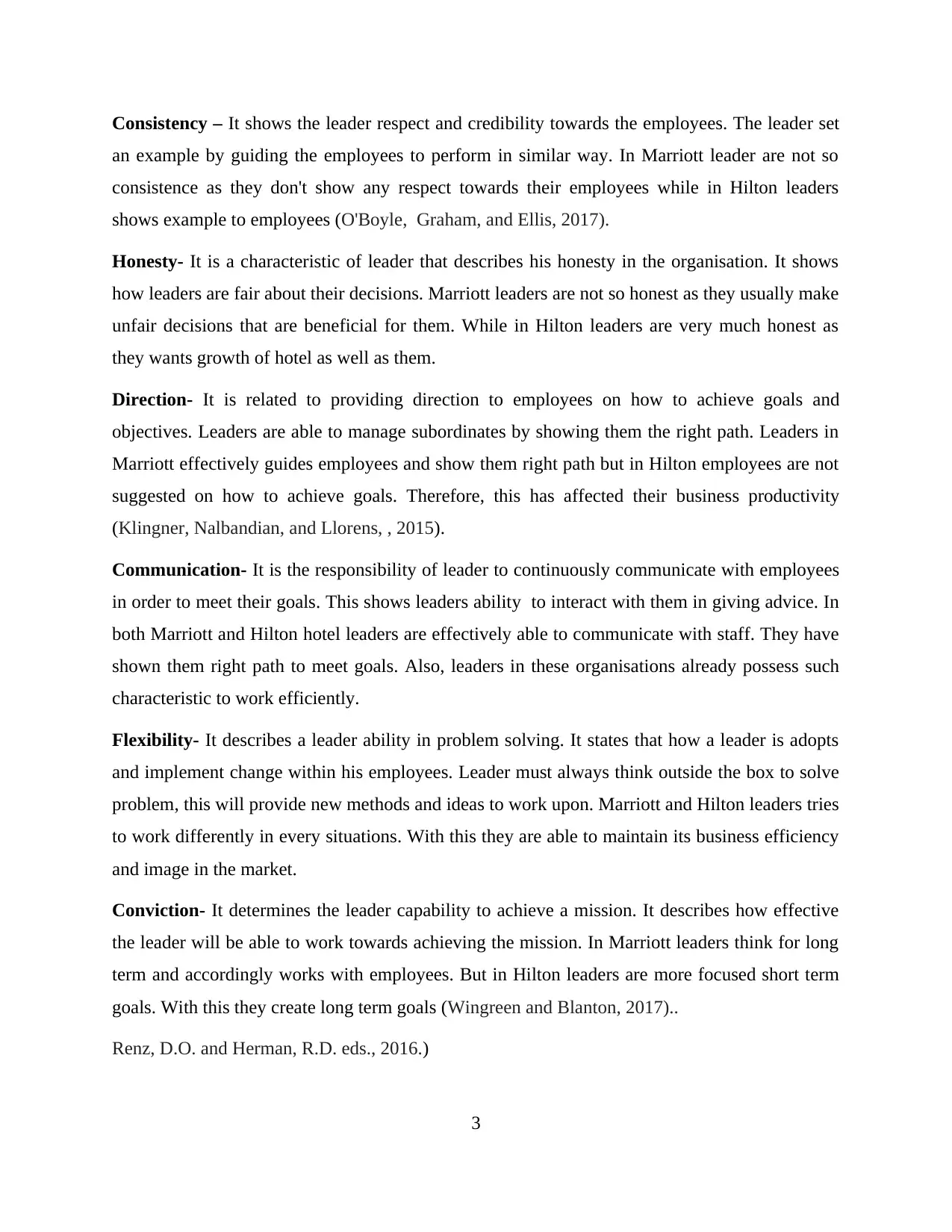
Consistency – It shows the leader respect and credibility towards the employees. The leader set
an example by guiding the employees to perform in similar way. In Marriott leader are not so
consistence as they don't show any respect towards their employees while in Hilton leaders
shows example to employees (O'Boyle, Graham, and Ellis, 2017).
Honesty- It is a characteristic of leader that describes his honesty in the organisation. It shows
how leaders are fair about their decisions. Marriott leaders are not so honest as they usually make
unfair decisions that are beneficial for them. While in Hilton leaders are very much honest as
they wants growth of hotel as well as them.
Direction- It is related to providing direction to employees on how to achieve goals and
objectives. Leaders are able to manage subordinates by showing them the right path. Leaders in
Marriott effectively guides employees and show them right path but in Hilton employees are not
suggested on how to achieve goals. Therefore, this has affected their business productivity
(Klingner, Nalbandian, and Llorens, , 2015).
Communication- It is the responsibility of leader to continuously communicate with employees
in order to meet their goals. This shows leaders ability to interact with them in giving advice. In
both Marriott and Hilton hotel leaders are effectively able to communicate with staff. They have
shown them right path to meet goals. Also, leaders in these organisations already possess such
characteristic to work efficiently.
Flexibility- It describes a leader ability in problem solving. It states that how a leader is adopts
and implement change within his employees. Leader must always think outside the box to solve
problem, this will provide new methods and ideas to work upon. Marriott and Hilton leaders tries
to work differently in every situations. With this they are able to maintain its business efficiency
and image in the market.
Conviction- It determines the leader capability to achieve a mission. It describes how effective
the leader will be able to work towards achieving the mission. In Marriott leaders think for long
term and accordingly works with employees. But in Hilton leaders are more focused short term
goals. With this they create long term goals (Wingreen and Blanton, 2017)..
Renz, D.O. and Herman, R.D. eds., 2016.)
3
an example by guiding the employees to perform in similar way. In Marriott leader are not so
consistence as they don't show any respect towards their employees while in Hilton leaders
shows example to employees (O'Boyle, Graham, and Ellis, 2017).
Honesty- It is a characteristic of leader that describes his honesty in the organisation. It shows
how leaders are fair about their decisions. Marriott leaders are not so honest as they usually make
unfair decisions that are beneficial for them. While in Hilton leaders are very much honest as
they wants growth of hotel as well as them.
Direction- It is related to providing direction to employees on how to achieve goals and
objectives. Leaders are able to manage subordinates by showing them the right path. Leaders in
Marriott effectively guides employees and show them right path but in Hilton employees are not
suggested on how to achieve goals. Therefore, this has affected their business productivity
(Klingner, Nalbandian, and Llorens, , 2015).
Communication- It is the responsibility of leader to continuously communicate with employees
in order to meet their goals. This shows leaders ability to interact with them in giving advice. In
both Marriott and Hilton hotel leaders are effectively able to communicate with staff. They have
shown them right path to meet goals. Also, leaders in these organisations already possess such
characteristic to work efficiently.
Flexibility- It describes a leader ability in problem solving. It states that how a leader is adopts
and implement change within his employees. Leader must always think outside the box to solve
problem, this will provide new methods and ideas to work upon. Marriott and Hilton leaders tries
to work differently in every situations. With this they are able to maintain its business efficiency
and image in the market.
Conviction- It determines the leader capability to achieve a mission. It describes how effective
the leader will be able to work towards achieving the mission. In Marriott leaders think for long
term and accordingly works with employees. But in Hilton leaders are more focused short term
goals. With this they create long term goals (Wingreen and Blanton, 2017)..
Renz, D.O. and Herman, R.D. eds., 2016.)
3
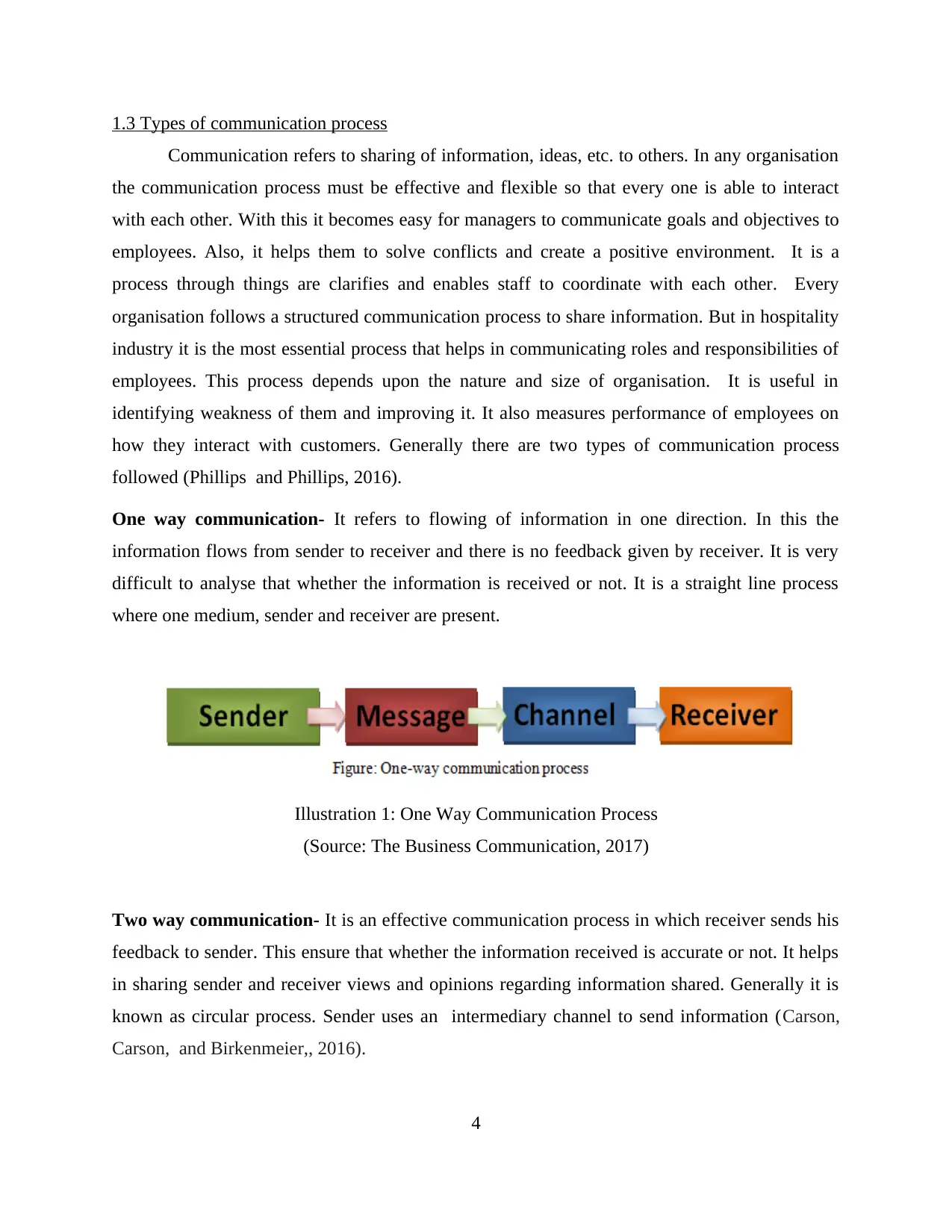
1.3 Types of communication process
Communication refers to sharing of information, ideas, etc. to others. In any organisation
the communication process must be effective and flexible so that every one is able to interact
with each other. With this it becomes easy for managers to communicate goals and objectives to
employees. Also, it helps them to solve conflicts and create a positive environment. It is a
process through things are clarifies and enables staff to coordinate with each other. Every
organisation follows a structured communication process to share information. But in hospitality
industry it is the most essential process that helps in communicating roles and responsibilities of
employees. This process depends upon the nature and size of organisation. It is useful in
identifying weakness of them and improving it. It also measures performance of employees on
how they interact with customers. Generally there are two types of communication process
followed (Phillips and Phillips, 2016).
One way communication- It refers to flowing of information in one direction. In this the
information flows from sender to receiver and there is no feedback given by receiver. It is very
difficult to analyse that whether the information is received or not. It is a straight line process
where one medium, sender and receiver are present.
Two way communication- It is an effective communication process in which receiver sends his
feedback to sender. This ensure that whether the information received is accurate or not. It helps
in sharing sender and receiver views and opinions regarding information shared. Generally it is
known as circular process. Sender uses an intermediary channel to send information (Carson,
Carson, and Birkenmeier,, 2016).
4
Illustration 1: One Way Communication Process
(Source: The Business Communication, 2017)
Communication refers to sharing of information, ideas, etc. to others. In any organisation
the communication process must be effective and flexible so that every one is able to interact
with each other. With this it becomes easy for managers to communicate goals and objectives to
employees. Also, it helps them to solve conflicts and create a positive environment. It is a
process through things are clarifies and enables staff to coordinate with each other. Every
organisation follows a structured communication process to share information. But in hospitality
industry it is the most essential process that helps in communicating roles and responsibilities of
employees. This process depends upon the nature and size of organisation. It is useful in
identifying weakness of them and improving it. It also measures performance of employees on
how they interact with customers. Generally there are two types of communication process
followed (Phillips and Phillips, 2016).
One way communication- It refers to flowing of information in one direction. In this the
information flows from sender to receiver and there is no feedback given by receiver. It is very
difficult to analyse that whether the information is received or not. It is a straight line process
where one medium, sender and receiver are present.
Two way communication- It is an effective communication process in which receiver sends his
feedback to sender. This ensure that whether the information received is accurate or not. It helps
in sharing sender and receiver views and opinions regarding information shared. Generally it is
known as circular process. Sender uses an intermediary channel to send information (Carson,
Carson, and Birkenmeier,, 2016).
4
Illustration 1: One Way Communication Process
(Source: The Business Communication, 2017)
⊘ This is a preview!⊘
Do you want full access?
Subscribe today to unlock all pages.

Trusted by 1+ million students worldwide
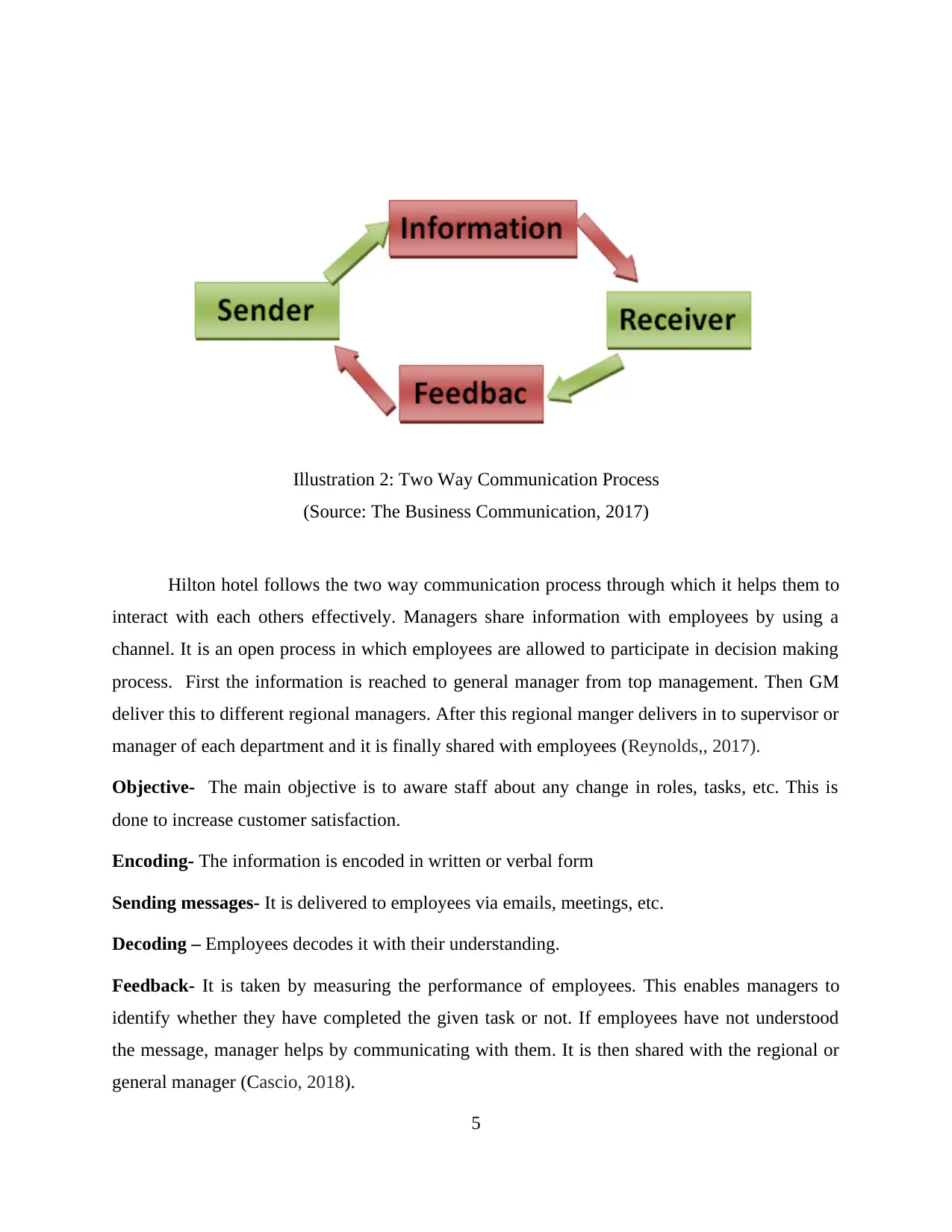
Hilton hotel follows the two way communication process through which it helps them to
interact with each others effectively. Managers share information with employees by using a
channel. It is an open process in which employees are allowed to participate in decision making
process. First the information is reached to general manager from top management. Then GM
deliver this to different regional managers. After this regional manger delivers in to supervisor or
manager of each department and it is finally shared with employees (Reynolds,, 2017).
Objective- The main objective is to aware staff about any change in roles, tasks, etc. This is
done to increase customer satisfaction.
Encoding- The information is encoded in written or verbal form
Sending messages- It is delivered to employees via emails, meetings, etc.
Decoding – Employees decodes it with their understanding.
Feedback- It is taken by measuring the performance of employees. This enables managers to
identify whether they have completed the given task or not. If employees have not understood
the message, manager helps by communicating with them. It is then shared with the regional or
general manager (Cascio, 2018).
5
Illustration 2: Two Way Communication Process
(Source: The Business Communication, 2017)
interact with each others effectively. Managers share information with employees by using a
channel. It is an open process in which employees are allowed to participate in decision making
process. First the information is reached to general manager from top management. Then GM
deliver this to different regional managers. After this regional manger delivers in to supervisor or
manager of each department and it is finally shared with employees (Reynolds,, 2017).
Objective- The main objective is to aware staff about any change in roles, tasks, etc. This is
done to increase customer satisfaction.
Encoding- The information is encoded in written or verbal form
Sending messages- It is delivered to employees via emails, meetings, etc.
Decoding – Employees decodes it with their understanding.
Feedback- It is taken by measuring the performance of employees. This enables managers to
identify whether they have completed the given task or not. If employees have not understood
the message, manager helps by communicating with them. It is then shared with the regional or
general manager (Cascio, 2018).
5
Illustration 2: Two Way Communication Process
(Source: The Business Communication, 2017)
Paraphrase This Document
Need a fresh take? Get an instant paraphrase of this document with our AI Paraphraser
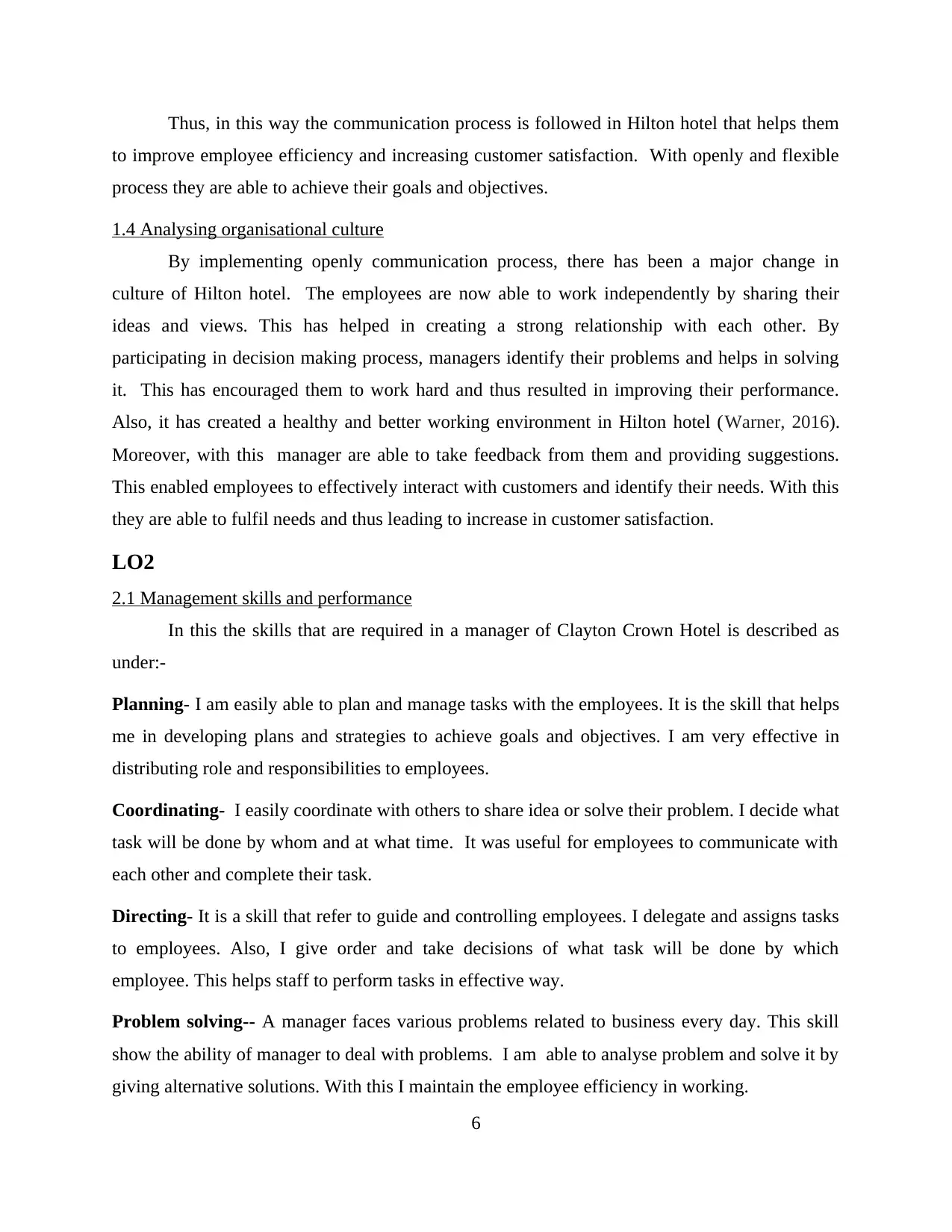
Thus, in this way the communication process is followed in Hilton hotel that helps them
to improve employee efficiency and increasing customer satisfaction. With openly and flexible
process they are able to achieve their goals and objectives.
1.4 Analysing organisational culture
By implementing openly communication process, there has been a major change in
culture of Hilton hotel. The employees are now able to work independently by sharing their
ideas and views. This has helped in creating a strong relationship with each other. By
participating in decision making process, managers identify their problems and helps in solving
it. This has encouraged them to work hard and thus resulted in improving their performance.
Also, it has created a healthy and better working environment in Hilton hotel (Warner, 2016).
Moreover, with this manager are able to take feedback from them and providing suggestions.
This enabled employees to effectively interact with customers and identify their needs. With this
they are able to fulfil needs and thus leading to increase in customer satisfaction.
LO2
2.1 Management skills and performance
In this the skills that are required in a manager of Clayton Crown Hotel is described as
under:-
Planning- I am easily able to plan and manage tasks with the employees. It is the skill that helps
me in developing plans and strategies to achieve goals and objectives. I am very effective in
distributing role and responsibilities to employees.
Coordinating- I easily coordinate with others to share idea or solve their problem. I decide what
task will be done by whom and at what time. It was useful for employees to communicate with
each other and complete their task.
Directing- It is a skill that refer to guide and controlling employees. I delegate and assigns tasks
to employees. Also, I give order and take decisions of what task will be done by which
employee. This helps staff to perform tasks in effective way.
Problem solving-- A manager faces various problems related to business every day. This skill
show the ability of manager to deal with problems. I am able to analyse problem and solve it by
giving alternative solutions. With this I maintain the employee efficiency in working.
6
to improve employee efficiency and increasing customer satisfaction. With openly and flexible
process they are able to achieve their goals and objectives.
1.4 Analysing organisational culture
By implementing openly communication process, there has been a major change in
culture of Hilton hotel. The employees are now able to work independently by sharing their
ideas and views. This has helped in creating a strong relationship with each other. By
participating in decision making process, managers identify their problems and helps in solving
it. This has encouraged them to work hard and thus resulted in improving their performance.
Also, it has created a healthy and better working environment in Hilton hotel (Warner, 2016).
Moreover, with this manager are able to take feedback from them and providing suggestions.
This enabled employees to effectively interact with customers and identify their needs. With this
they are able to fulfil needs and thus leading to increase in customer satisfaction.
LO2
2.1 Management skills and performance
In this the skills that are required in a manager of Clayton Crown Hotel is described as
under:-
Planning- I am easily able to plan and manage tasks with the employees. It is the skill that helps
me in developing plans and strategies to achieve goals and objectives. I am very effective in
distributing role and responsibilities to employees.
Coordinating- I easily coordinate with others to share idea or solve their problem. I decide what
task will be done by whom and at what time. It was useful for employees to communicate with
each other and complete their task.
Directing- It is a skill that refer to guide and controlling employees. I delegate and assigns tasks
to employees. Also, I give order and take decisions of what task will be done by which
employee. This helps staff to perform tasks in effective way.
Problem solving-- A manager faces various problems related to business every day. This skill
show the ability of manager to deal with problems. I am able to analyse problem and solve it by
giving alternative solutions. With this I maintain the employee efficiency in working.
6
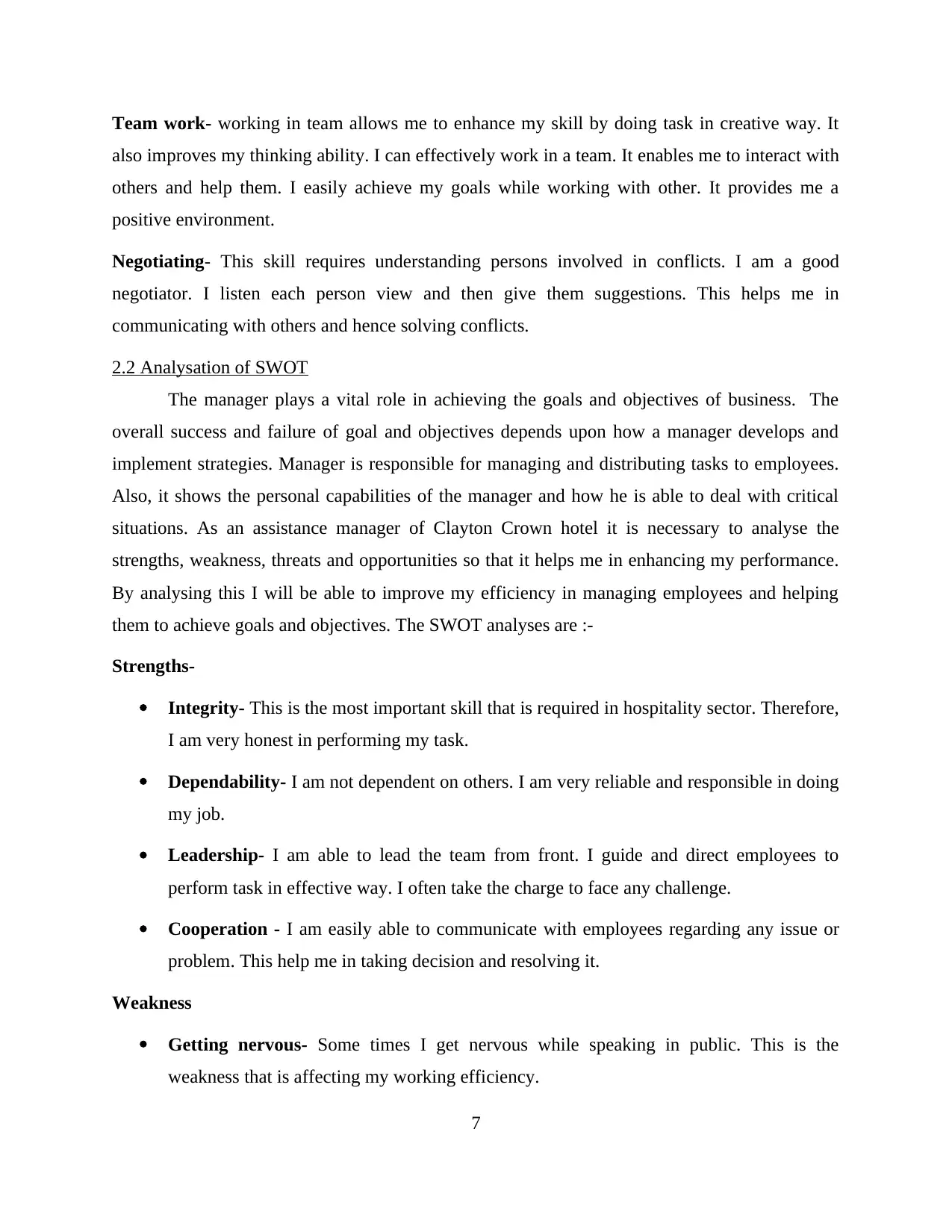
Team work- working in team allows me to enhance my skill by doing task in creative way. It
also improves my thinking ability. I can effectively work in a team. It enables me to interact with
others and help them. I easily achieve my goals while working with other. It provides me a
positive environment.
Negotiating- This skill requires understanding persons involved in conflicts. I am a good
negotiator. I listen each person view and then give them suggestions. This helps me in
communicating with others and hence solving conflicts.
2.2 Analysation of SWOT
The manager plays a vital role in achieving the goals and objectives of business. The
overall success and failure of goal and objectives depends upon how a manager develops and
implement strategies. Manager is responsible for managing and distributing tasks to employees.
Also, it shows the personal capabilities of the manager and how he is able to deal with critical
situations. As an assistance manager of Clayton Crown hotel it is necessary to analyse the
strengths, weakness, threats and opportunities so that it helps me in enhancing my performance.
By analysing this I will be able to improve my efficiency in managing employees and helping
them to achieve goals and objectives. The SWOT analyses are :-
Strengths-
Integrity- This is the most important skill that is required in hospitality sector. Therefore,
I am very honest in performing my task.
Dependability- I am not dependent on others. I am very reliable and responsible in doing
my job.
Leadership- I am able to lead the team from front. I guide and direct employees to
perform task in effective way. I often take the charge to face any challenge.
Cooperation - I am easily able to communicate with employees regarding any issue or
problem. This help me in taking decision and resolving it.
Weakness
Getting nervous- Some times I get nervous while speaking in public. This is the
weakness that is affecting my working efficiency.
7
also improves my thinking ability. I can effectively work in a team. It enables me to interact with
others and help them. I easily achieve my goals while working with other. It provides me a
positive environment.
Negotiating- This skill requires understanding persons involved in conflicts. I am a good
negotiator. I listen each person view and then give them suggestions. This helps me in
communicating with others and hence solving conflicts.
2.2 Analysation of SWOT
The manager plays a vital role in achieving the goals and objectives of business. The
overall success and failure of goal and objectives depends upon how a manager develops and
implement strategies. Manager is responsible for managing and distributing tasks to employees.
Also, it shows the personal capabilities of the manager and how he is able to deal with critical
situations. As an assistance manager of Clayton Crown hotel it is necessary to analyse the
strengths, weakness, threats and opportunities so that it helps me in enhancing my performance.
By analysing this I will be able to improve my efficiency in managing employees and helping
them to achieve goals and objectives. The SWOT analyses are :-
Strengths-
Integrity- This is the most important skill that is required in hospitality sector. Therefore,
I am very honest in performing my task.
Dependability- I am not dependent on others. I am very reliable and responsible in doing
my job.
Leadership- I am able to lead the team from front. I guide and direct employees to
perform task in effective way. I often take the charge to face any challenge.
Cooperation - I am easily able to communicate with employees regarding any issue or
problem. This help me in taking decision and resolving it.
Weakness
Getting nervous- Some times I get nervous while speaking in public. This is the
weakness that is affecting my working efficiency.
7
⊘ This is a preview!⊘
Do you want full access?
Subscribe today to unlock all pages.

Trusted by 1+ million students worldwide
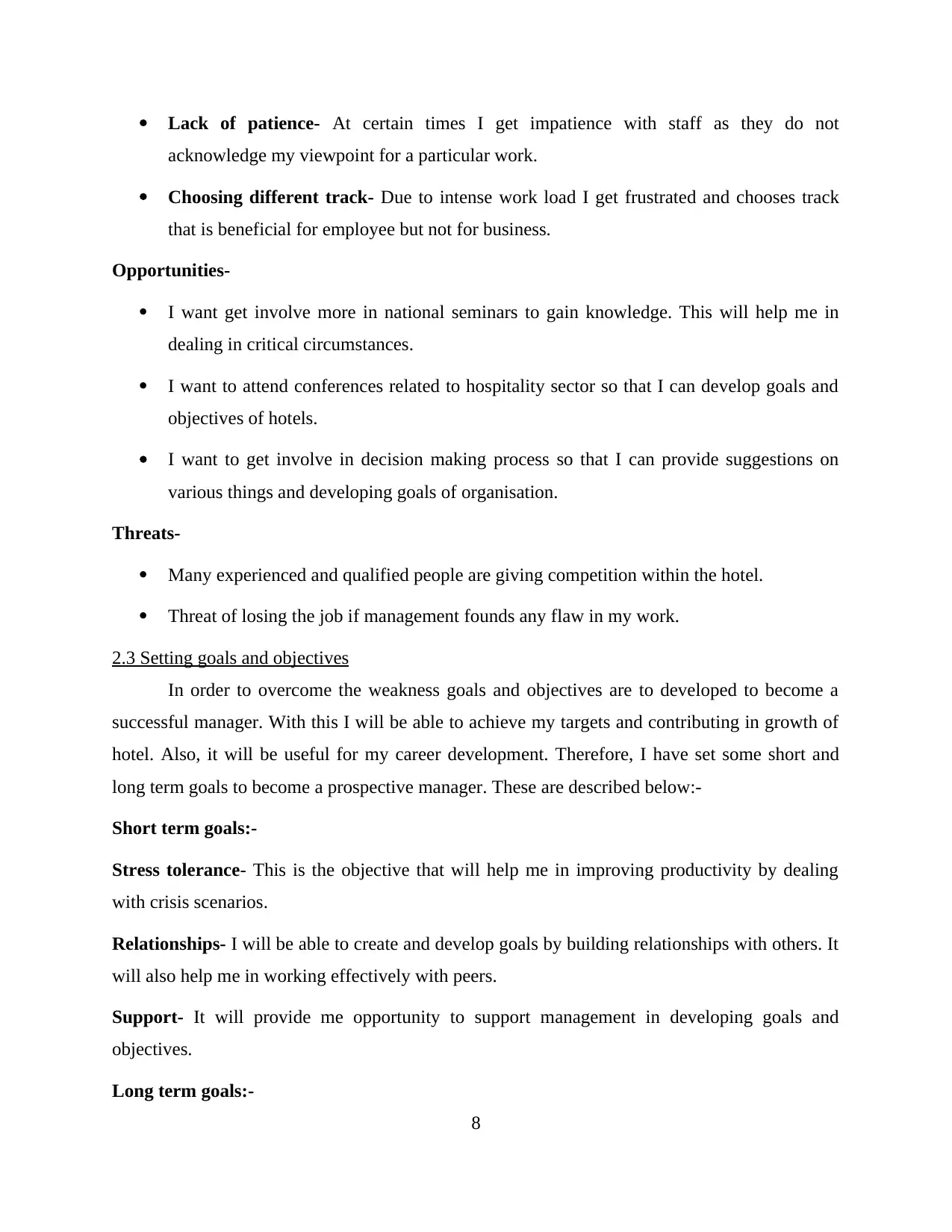
Lack of patience- At certain times I get impatience with staff as they do not
acknowledge my viewpoint for a particular work.
Choosing different track- Due to intense work load I get frustrated and chooses track
that is beneficial for employee but not for business.
Opportunities-
I want get involve more in national seminars to gain knowledge. This will help me in
dealing in critical circumstances.
I want to attend conferences related to hospitality sector so that I can develop goals and
objectives of hotels.
I want to get involve in decision making process so that I can provide suggestions on
various things and developing goals of organisation.
Threats-
Many experienced and qualified people are giving competition within the hotel.
Threat of losing the job if management founds any flaw in my work.
2.3 Setting goals and objectives
In order to overcome the weakness goals and objectives are to developed to become a
successful manager. With this I will be able to achieve my targets and contributing in growth of
hotel. Also, it will be useful for my career development. Therefore, I have set some short and
long term goals to become a prospective manager. These are described below:-
Short term goals:-
Stress tolerance- This is the objective that will help me in improving productivity by dealing
with crisis scenarios.
Relationships- I will be able to create and develop goals by building relationships with others. It
will also help me in working effectively with peers.
Support- It will provide me opportunity to support management in developing goals and
objectives.
Long term goals:-
8
acknowledge my viewpoint for a particular work.
Choosing different track- Due to intense work load I get frustrated and chooses track
that is beneficial for employee but not for business.
Opportunities-
I want get involve more in national seminars to gain knowledge. This will help me in
dealing in critical circumstances.
I want to attend conferences related to hospitality sector so that I can develop goals and
objectives of hotels.
I want to get involve in decision making process so that I can provide suggestions on
various things and developing goals of organisation.
Threats-
Many experienced and qualified people are giving competition within the hotel.
Threat of losing the job if management founds any flaw in my work.
2.3 Setting goals and objectives
In order to overcome the weakness goals and objectives are to developed to become a
successful manager. With this I will be able to achieve my targets and contributing in growth of
hotel. Also, it will be useful for my career development. Therefore, I have set some short and
long term goals to become a prospective manager. These are described below:-
Short term goals:-
Stress tolerance- This is the objective that will help me in improving productivity by dealing
with crisis scenarios.
Relationships- I will be able to create and develop goals by building relationships with others. It
will also help me in working effectively with peers.
Support- It will provide me opportunity to support management in developing goals and
objectives.
Long term goals:-
8
Paraphrase This Document
Need a fresh take? Get an instant paraphrase of this document with our AI Paraphraser
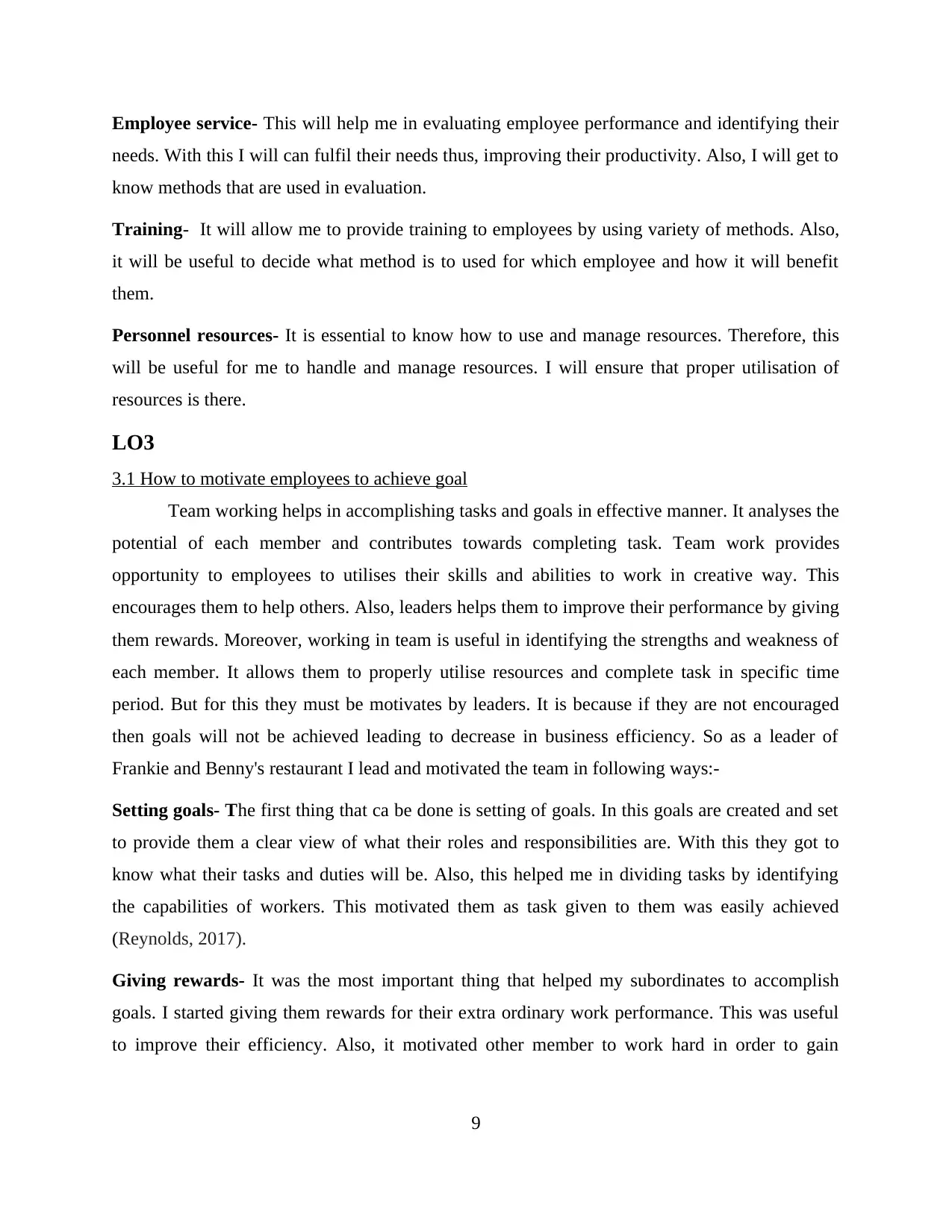
Employee service- This will help me in evaluating employee performance and identifying their
needs. With this I will can fulfil their needs thus, improving their productivity. Also, I will get to
know methods that are used in evaluation.
Training- It will allow me to provide training to employees by using variety of methods. Also,
it will be useful to decide what method is to used for which employee and how it will benefit
them.
Personnel resources- It is essential to know how to use and manage resources. Therefore, this
will be useful for me to handle and manage resources. I will ensure that proper utilisation of
resources is there.
LO3
3.1 How to motivate employees to achieve goal
Team working helps in accomplishing tasks and goals in effective manner. It analyses the
potential of each member and contributes towards completing task. Team work provides
opportunity to employees to utilises their skills and abilities to work in creative way. This
encourages them to help others. Also, leaders helps them to improve their performance by giving
them rewards. Moreover, working in team is useful in identifying the strengths and weakness of
each member. It allows them to properly utilise resources and complete task in specific time
period. But for this they must be motivates by leaders. It is because if they are not encouraged
then goals will not be achieved leading to decrease in business efficiency. So as a leader of
Frankie and Benny's restaurant I lead and motivated the team in following ways:-
Setting goals- The first thing that ca be done is setting of goals. In this goals are created and set
to provide them a clear view of what their roles and responsibilities are. With this they got to
know what their tasks and duties will be. Also, this helped me in dividing tasks by identifying
the capabilities of workers. This motivated them as task given to them was easily achieved
(Reynolds, 2017).
Giving rewards- It was the most important thing that helped my subordinates to accomplish
goals. I started giving them rewards for their extra ordinary work performance. This was useful
to improve their efficiency. Also, it motivated other member to work hard in order to gain
9
needs. With this I will can fulfil their needs thus, improving their productivity. Also, I will get to
know methods that are used in evaluation.
Training- It will allow me to provide training to employees by using variety of methods. Also,
it will be useful to decide what method is to used for which employee and how it will benefit
them.
Personnel resources- It is essential to know how to use and manage resources. Therefore, this
will be useful for me to handle and manage resources. I will ensure that proper utilisation of
resources is there.
LO3
3.1 How to motivate employees to achieve goal
Team working helps in accomplishing tasks and goals in effective manner. It analyses the
potential of each member and contributes towards completing task. Team work provides
opportunity to employees to utilises their skills and abilities to work in creative way. This
encourages them to help others. Also, leaders helps them to improve their performance by giving
them rewards. Moreover, working in team is useful in identifying the strengths and weakness of
each member. It allows them to properly utilise resources and complete task in specific time
period. But for this they must be motivates by leaders. It is because if they are not encouraged
then goals will not be achieved leading to decrease in business efficiency. So as a leader of
Frankie and Benny's restaurant I lead and motivated the team in following ways:-
Setting goals- The first thing that ca be done is setting of goals. In this goals are created and set
to provide them a clear view of what their roles and responsibilities are. With this they got to
know what their tasks and duties will be. Also, this helped me in dividing tasks by identifying
the capabilities of workers. This motivated them as task given to them was easily achieved
(Reynolds, 2017).
Giving rewards- It was the most important thing that helped my subordinates to accomplish
goals. I started giving them rewards for their extra ordinary work performance. This was useful
to improve their efficiency. Also, it motivated other member to work hard in order to gain
9
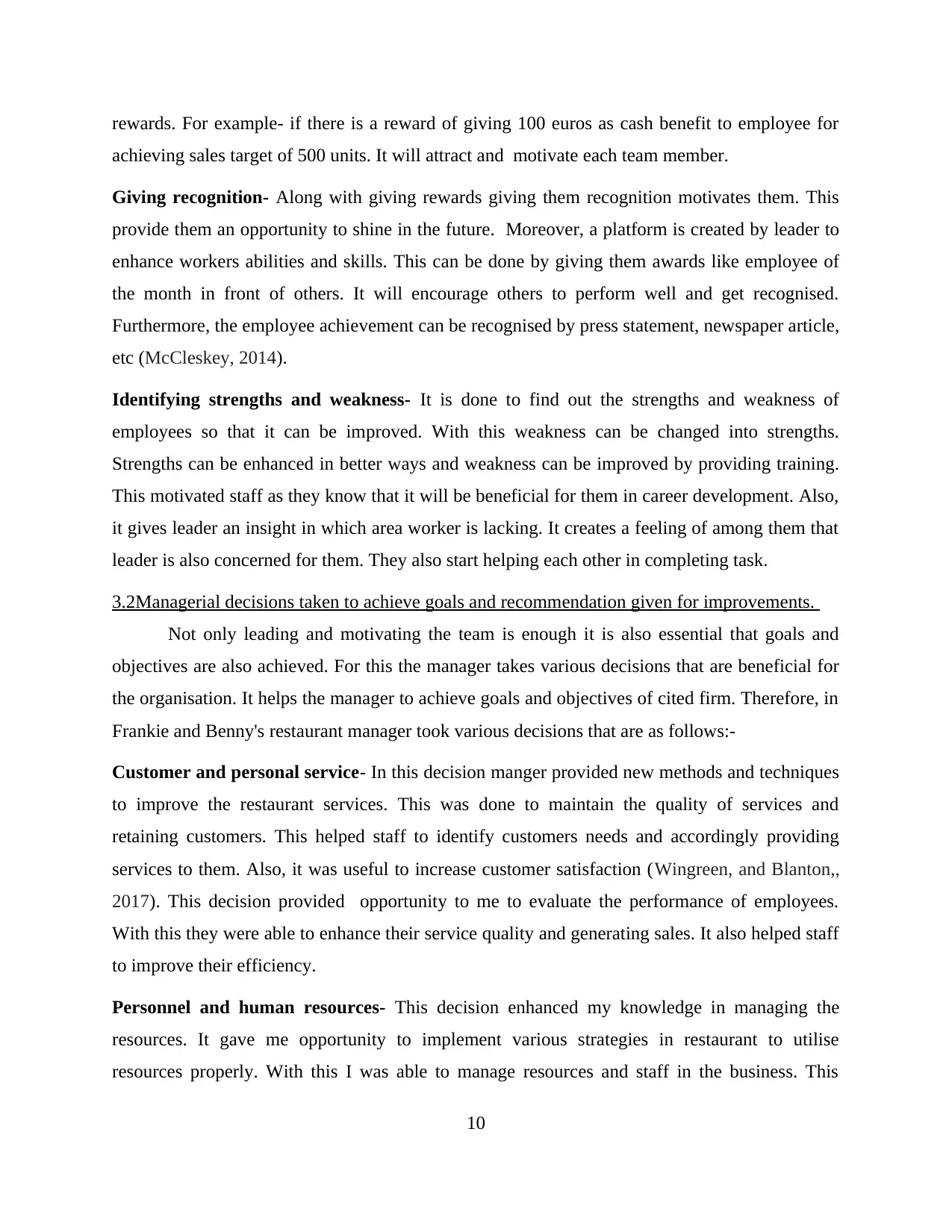
rewards. For example- if there is a reward of giving 100 euros as cash benefit to employee for
achieving sales target of 500 units. It will attract and motivate each team member.
Giving recognition- Along with giving rewards giving them recognition motivates them. This
provide them an opportunity to shine in the future. Moreover, a platform is created by leader to
enhance workers abilities and skills. This can be done by giving them awards like employee of
the month in front of others. It will encourage others to perform well and get recognised.
Furthermore, the employee achievement can be recognised by press statement, newspaper article,
etc (McCleskey, 2014).
Identifying strengths and weakness- It is done to find out the strengths and weakness of
employees so that it can be improved. With this weakness can be changed into strengths.
Strengths can be enhanced in better ways and weakness can be improved by providing training.
This motivated staff as they know that it will be beneficial for them in career development. Also,
it gives leader an insight in which area worker is lacking. It creates a feeling of among them that
leader is also concerned for them. They also start helping each other in completing task.
3.2Managerial decisions taken to achieve goals and recommendation given for improvements.
Not only leading and motivating the team is enough it is also essential that goals and
objectives are also achieved. For this the manager takes various decisions that are beneficial for
the organisation. It helps the manager to achieve goals and objectives of cited firm. Therefore, in
Frankie and Benny's restaurant manager took various decisions that are as follows:-
Customer and personal service- In this decision manger provided new methods and techniques
to improve the restaurant services. This was done to maintain the quality of services and
retaining customers. This helped staff to identify customers needs and accordingly providing
services to them. Also, it was useful to increase customer satisfaction (Wingreen, and Blanton,,
2017). This decision provided opportunity to me to evaluate the performance of employees.
With this they were able to enhance their service quality and generating sales. It also helped staff
to improve their efficiency.
Personnel and human resources- This decision enhanced my knowledge in managing the
resources. It gave me opportunity to implement various strategies in restaurant to utilise
resources properly. With this I was able to manage resources and staff in the business. This
10
achieving sales target of 500 units. It will attract and motivate each team member.
Giving recognition- Along with giving rewards giving them recognition motivates them. This
provide them an opportunity to shine in the future. Moreover, a platform is created by leader to
enhance workers abilities and skills. This can be done by giving them awards like employee of
the month in front of others. It will encourage others to perform well and get recognised.
Furthermore, the employee achievement can be recognised by press statement, newspaper article,
etc (McCleskey, 2014).
Identifying strengths and weakness- It is done to find out the strengths and weakness of
employees so that it can be improved. With this weakness can be changed into strengths.
Strengths can be enhanced in better ways and weakness can be improved by providing training.
This motivated staff as they know that it will be beneficial for them in career development. Also,
it gives leader an insight in which area worker is lacking. It creates a feeling of among them that
leader is also concerned for them. They also start helping each other in completing task.
3.2Managerial decisions taken to achieve goals and recommendation given for improvements.
Not only leading and motivating the team is enough it is also essential that goals and
objectives are also achieved. For this the manager takes various decisions that are beneficial for
the organisation. It helps the manager to achieve goals and objectives of cited firm. Therefore, in
Frankie and Benny's restaurant manager took various decisions that are as follows:-
Customer and personal service- In this decision manger provided new methods and techniques
to improve the restaurant services. This was done to maintain the quality of services and
retaining customers. This helped staff to identify customers needs and accordingly providing
services to them. Also, it was useful to increase customer satisfaction (Wingreen, and Blanton,,
2017). This decision provided opportunity to me to evaluate the performance of employees.
With this they were able to enhance their service quality and generating sales. It also helped staff
to improve their efficiency.
Personnel and human resources- This decision enhanced my knowledge in managing the
resources. It gave me opportunity to implement various strategies in restaurant to utilise
resources properly. With this I was able to manage resources and staff in the business. This
10
⊘ This is a preview!⊘
Do you want full access?
Subscribe today to unlock all pages.

Trusted by 1+ million students worldwide
1 out of 17
Related Documents
Your All-in-One AI-Powered Toolkit for Academic Success.
+13062052269
info@desklib.com
Available 24*7 on WhatsApp / Email
![[object Object]](/_next/static/media/star-bottom.7253800d.svg)
Unlock your academic potential
Copyright © 2020–2025 A2Z Services. All Rights Reserved. Developed and managed by ZUCOL.





